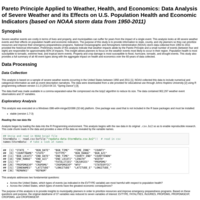Recently Published

Exploring Various Classification Models
A quick look comparison of three classification methods using a modified version of the UCI Mushroom Data set

Pareto Principle Applied to Weather, Health, and Economics: Data Analysis of Severe Weather and its Effects on U.S. Population Health and Economic Indicators (based on NOAA storm data from 1950-2011)
Severe weather events are costly in terms of lives and property. Municipalities can suffer for years from the impact of a single event. This analysis looks at 48 severe weather events and their effects on population health and economic indicators. The purpose of this study is to provide information to state, county, and city planners so they can prioritize resources and improve their emergency preparedness programs. Preliminary results of this analysis indicate that weather impacts abide by the Pareto Principle and a small number of events (between four and eight) are responsible for approximately 80% of impacts. This insight allows planners to focus on threats most likely to occur in their region.

Pareto Principle as Applied to Weather, Health, and Economics: Data Analysis of Severe Weather and its Effects on U.S. Population Health and Economic Indicators (based on NOAA data from 1950-2011)
Severe weather events are costly in terms of lives and property. Municipalities can suffer for years from the impact of a single event. This analysis looks at 48 severe weather events and their effects on population health and economic indicators. The purpose of this study is to provide information to state, county, and city planners so they can prioritize resources and improve their emergency preparedness programs. Preliminary results of this analysis indicate that weather impacts abide by the Pareto Principle and a small number of events (between four and eight) are responsible for approximately 80% of impacts. This insight allows planners to focus on threats most likely to occur in their region.